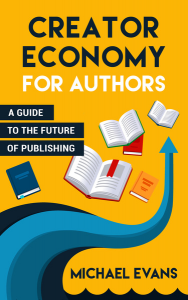
Today’s post is excerpted from the forthcoming book Creator Economy for Authors by Michael Evans (@mevansinked), co-founder of Ream.
During my first full year of publishing, I made almost $200. I had three books in my catalogue and dabbled in Amazon Ads. In 2019, I made $412 publishing three more books. In 2020, I had my breakout year, generating $7,500 in revenue for my business. I was ecstatic. I had several months where I made $1,000 a row and I published six new books that year.
But something darker happened.
Almost all of that $7,500 in revenue went to Facebook and Amazon Ads. In fact, I spent $2,000 out of pocket just testing ads to get things working for my series. And once I got them working, I often had to spend 20+ hours a week managing them.
It was stressful—anxiety-inducing, in fact. At the time I thought it was the only way I could make it as an author. And I was willing to do whatever it took to turn my dreams into reality.
That was until I burned out. Suddenly it felt like I was writing more just to hit my next release than because I had a story to tell. I started to miss my deadlines, until I ultimately stopped midway through the next draft of my book.
But something else happened during this time, another algorithmic force leading me to my burnout. It was YouTube. I had started uploading vlogs to my YouTube channel in September 2020. By November 2020, I had nearly half a million views on the channel alone during that month and made almost $2,000 in Google AdSense. I also made several hundred dollars selling my books with no ads and no calls-to-action during my videos.
What followed was the greatest rollercoaster I have ever experienced. I started creating content to try and garner as many views as possible. I garnered 2 million views on my first two weeks on TikTok and started traveling the country to meet celebrities, taking the third door to access opportunities that ranged from meeting Elon Musk’s executive assistant to kayaking to the back of Joe Rogan’s house and on accident meeting one of the largest concert promoters in the world. I also started live streaming for a start-up platform run by Sean Parker, creating 1,000 hours of content on the platform.
This sounds like everything was going splendidly. But in reality, I didn’t have a broader creator strategy. I was simply a content producer, chasing the algorithmic highs and feeling despondent and, at times, worthless during the algorithmic lows.
For many authors, prioritizing ads as your primary marketing lever is unhealthy and at times unprofitable. And often limiting. That’s where the three pillars of our author creator marketing strategy come in.
Pillar #1: Create where your readers hang out, but not everywhere your readers hang out.
For the longest time, I felt a pressure to be creating in “hot spaces” where everyone was getting all these sales in. But I realized that if I don’t typically consume content there, then there is a low-chance that I’ll enjoy creating there.
Some authors, particularly romance authors, may be reading this and saying to themselves, “I hate TikTok, but my readers love it!” That is a fair statement. But creating content where your readers hang out does not mean creating content everywhere. Romance readers have formed massive communities on virtually every social platform and consume content in almost every format. Specific subgenres, of course, are more predominant in specific spaces. But I would imagine that a podcast directed to a specific audience of romance readers could do really well, such as Heaving Bosoms, which has over 700 people paying them monthly for exclusive access to some episodes in their subscription program.
The key here is that although many target audiences exist in multiple locations on the internet, it is rare that an author has the bandwidth at the early stages in their career to create in multiple formats. Thus, it’s essential to pick a content format and continue leveling up and growing your audience until, if ever, you’d like to expand into other formats.
More concretely, don’t feel pressure to keep up with a blog, a podcast, Instagram posts, and daily TikTok content at the same time. Author creators know that cumulative advantage comes from leveraging your audience and skill growth in a particular content format, not by spreading yourself so thin you risk adding stress, not new readers, to your life.
That said, picking a particular content format isn’t so easy. That’s why we have our second pillar.
Pillar #2: Create what you love, but have it be integral to your world.
If you take nothing else away from these pillars, remember to always make it fun. The idea of being an author-creator when marketing your books is to make the discovery process fun, not something that feels like a chore.
Creating content should be creative, something that enhances the worlds you are building instead of being a distraction. And if done correctly, it can be a fertile testing ground to see what new story ideas, characters, and problems your readers are most interested in.
However, many authors can sometimes have fun creating content that is, well, maybe not related to things their target audience is interested in. Or even more nefarious, things that their target audience is interested in, but doesn’t help authors build their unique brand.
The Tilt is a publication all about the creator economy started by Joe Pulizzi, one of the foremost experts on content marketing. The reason it’s called the Tilt is because each creator has to have a unique tilt or edge, if you will, over the competition in order to succeed.
What does this mean?
Well, let’s say you love creating true crime podcasts and you are a thriller author. Your true crime podcasts are maybe specifically focused on serial killers in the Southern United States. You have niched down your audience pretty well here and are likely appealing to law enforcement as well as true crime junkies in the South.
Yet, even with that niche there are dozens of podcasts that regularly focus on topics for this audience, such as Southern Fried True Crime. In order to succeed, you need to be able to do something different, whether that is combining two existing styles you love, niching down even further, or having some unique value-add that no one else in your market is providing.
Ideally, this content tilt is baked into the value proposition of your larger brand. The same things your readers will love about the things you write are hopefully the same kinds of things that can separate you from the pack and get people interested in your content. Tilting authentically is the key to being able to build a sustainable business as an author-creator: building a world that is true to you, has the potential to evolve and grow with time, and has many entry points for new fans, all centered around your stories.
In short, create about what you’re passionate about. And those things should probably be interconnected, or at the very least, similar to your story.
Pillar #3: Create how you want. Seriously, you write the rules.
I’m here to give you permission to post whenever you damn want. In the world of the creator economy, it’s all about building your dream. Not listening to the cookie-cutter advice of gurus that at times don’t have your best interests at heart. With that said, with each content format in the paragraphs below, I’ll detail best practices and why it’s probably useful to post short-form content more often than, say, podcasts for the purpose of discovery.
However, even the best practices are just guidelines. They don’t stipulate how often you need to post to tickle a specific algorithm just right. Instead, I’m focused on the psychology of cold audiences who discover your content and how to convert them into warmer leads (aka fans) that begin to look forward to your content. It’s this slow building flywheel that can lead to exponential growth due to cumulative effects.
Here’s why: Every social platform rewards retention more than anything else. To define retention, it’s the percentage of time that a creator’s audience watches a specific piece of content compared to its total duration. Platforms like YouTube presume that if someone watches 80% of a three-minute video, odds are that the content was more engaging and satisfying than watching 30% of a ten-minute video.
In practice, one piece of content will only drive direct sales to your brand for a short, concentrated burst. As author-creators, we are not one-hit wonders chasing the highs that other people might be teaching us how to pursue, and platforms now tend to optimize for retention across pieces of content. This is especially true for YouTube.
If you upload five videos and a high percentage of a cold audience who clicks into video 1, also go on to watch videos 2, 3, 4, and 5, YouTube knows it has a winning creator. An audience is building a relationship with this person. This ultimately means more time on their platform.
Writers choosing to pursue newsletters or blogs or podcasts may be wondering how any of this retention stuff even applies to them. The truth is that the psychology embedded into the design of these platforms is something we can all learn from. And this is almost identical to how Amazon works. Although they are even more opaque about the inner workings of their algorithmic discovery system, authors know that a series with high read-through rate is just about the best thing that can happen for someone’s career. These other types of content are only extensions of that core psychology. When you develop a relationship with your audience that feels real and makes them want to come back for more, you win.
There’s no way to hack this system. If there was, everyone would do it. The key to creating successful content as an author-creator lies in the same ingredients that make your stories so great. It’s about creating a world people want to be a part of. A process you want to regularly engage with. And creating things that inspire you and feed into your larger vision and mission for your career.
Note from Jane: Join me and Michael for a free discussion about The Creator Economy on Jan. 8.

Michael Evans is the author of over a dozen sci-fi thriller novels and the co-founder and CEO of Ream, the subscription platform by fiction authors for fiction authors. He is currently studying Neuroscience at Harvard and is fascinated by the science of storytelling, media, and all things creators. In his free time, he can often be found reading, hiking, or uploading vlogs of his life to the internet. He is originally from Charleston, South Carolina, but can be found voyaging across the world to meet amazing creatives and thinkers who inspire better futures. Learn more at his website.


“It’s about creating a world people want to be a part of.”
I would love to do this – I have literally millions of words about how scenes were created and what they are intended to do and mean – from the Notes I create while writing, and keep.
I created a Patreon at one point, and still have the files for the scenes in the first few chapters of my mainstream trilogy’s first novel. I put a lot of effort into it – so I have a pattern and a system.
And only ever had one supporter/fan!
These things snowball: fans bring questions and appreciation to what is written, and help generate more. But I was unable to get the process started (and it took a fair amount of time), so I stored it all up and stopped trying.
I guess I’ll have to wait until I’m an ‘overnight’ success; the second novel is published (the first took 15 years, the second 7), and I hope to finish the third in less than five. I have extremely limited energy due to chronic illness, and that makes everything, from writing to marketing to extras such as interacting with fans, hugely more difficult.
I’m working on it; but realistic expectations don’t include getting better/faster – unless, as those of us with ME/CFS are hoping hard for, the research into long covid provides tools for healing and treating other post-viral syndromes such as mine.
Meanwhile, so many ideas languish, including that world to be shared.
Great post!
It’s an excellent article. We write the rules, everything is in our hands, but we also need to think about the end user. Really helpful.
As a newbie, I appreciate these tips. Thank you for sharing the benefit of your experience!